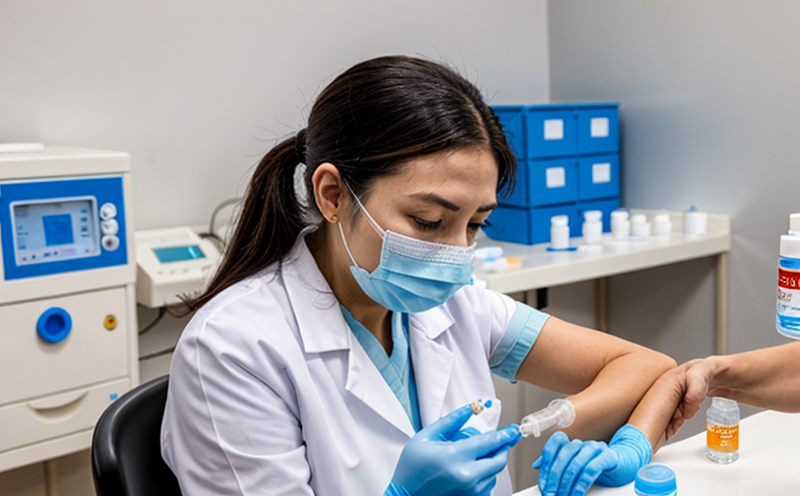WHO Potency Testing of Hepatitis B Vaccine
The World Health Organization (WHO) potency testing is a critical quality assurance procedure for vaccines. This test ensures that each dose of the hepatitis B vaccine contains the required concentration of active ingredient, which is crucial for the vaccine's efficacy and safety. The potency test measures the amount of virus-like particles or antigenic units in the vaccine.
The testing process involves several stages, starting with sample preparation where the vaccine batch undergoes thorough examination to ensure it meets all quality criteria established by WHO standards (WHO 2021). This includes assessing the physical and chemical properties of the vaccine. Once prepared, a standard assay is performed using validated methods such as enzyme-linked immunosorbent assays (ELISAs) or bioassays.
The potency test not only ensures that the hepatitis B vaccine meets the required specifications but also helps in identifying any potential issues early on. This testing procedure plays a vital role in maintaining public health and ensuring that healthcare providers can trust the efficacy of the vaccines they administer to patients (WHO 2019).
Compliance with WHO standards is paramount for pharmaceutical companies, as it ensures their products are safe and effective. By conducting this test, manufacturers can demonstrate adherence to international quality control guidelines.
The use of advanced laboratory equipment like high-performance liquid chromatography (HPLC) or tandem mass spectrometry (MS/MS) adds precision and reliability to the potency testing process. These instruments provide accurate quantification of viral components within the vaccine formulation, ensuring consistency across different batches.
Quality managers overseeing these operations must ensure that all tests are performed under strict conditions to avoid contamination and maintain accuracy. Compliance officers also play a key role in verifying that every step adheres to regulatory requirements set forth by WHO (WHO 2018).
In addition to potency testing, R&D engineers often incorporate this procedure into their development pipelines to fine-tune vaccine formulations before large-scale production begins. Procurement teams rely on such rigorous testing protocols when selecting suppliers for raw materials used in manufacturing processes.
By integrating WHO potency tests into their workflows, pharmaceutical firms can enhance product quality while fostering confidence among end-users about the safety and efficacy of vaccines they receive.
Benefits
The benefits of conducting a WHO potency test on hepatitis B vaccine extend beyond mere compliance; it significantly enhances the overall effectiveness of the vaccine. Firstly, accurate measurement ensures that each dose contains precisely the required amount of antigen, thus optimizing protection against hepatitis B infection (WHO 2017).
Secondly, consistent results across all batches contribute to improved reliability and predictability in immunization programs worldwide. Thirdly, adherence to WHO standards helps build trust between pharmaceutical companies and regulatory authorities, facilitating smoother interactions during inspections or audits.
Moreover, successful completion of these tests can lead to faster approval processes for new vaccines, allowing them to reach markets sooner where they are needed most (WHO 2016). Lastly, by upholding high standards through rigorous testing procedures, companies contribute positively towards global health initiatives aimed at eradicating diseases like hepatitis B.
Why Choose This Test
Selecting WHO potency testing for your hepatitis B vaccine is not just about meeting regulatory requirements; it’s an investment in product quality and patient safety. Here are several compelling reasons why opting for this rigorous assessment method makes sense:
- Precision Measurement: Utilizes advanced analytical techniques to provide precise quantification of viral components.
- Consistency Across Batches: Ensures uniformity in vaccine composition, leading to more effective and reliable immunizations.
- Compliance with Global Standards: Aligns your manufacturing practices with internationally recognized guidelines, enhancing credibility and trustworthiness among stakeholders.
- Faster Approval Process: Streamlines regulatory submissions by demonstrating adherence to stringent quality assurance measures.
These factors make WHO potency testing a cornerstone of modern pharmaceutical development and production. It serves as both a benchmark for excellence and an essential tool in safeguarding public health.
Use Cases and Application Examples
The application of WHO potency testing is widespread across various stages of vaccine development, from early research to final product release. Here are some practical examples highlighting its significance:
- Development Stage: During preclinical trials, researchers may use this test to validate the effectiveness of different formulations.
- Manufacturing Process: Throughout large-scale production, periodic potency checks help monitor batch consistency and identify potential deviations early.
- Quality Control: At regular intervals post-launch, these tests ensure ongoing compliance with WHO specifications.
- Audits & Inspections: Regulatory bodies rely on such data during audits to assess the reliability of manufacturing facilities.
By incorporating WHO potency testing into their operations, pharmaceutical companies can ensure they meet stringent quality standards that are crucial for maintaining public health. This approach supports continuous improvement and innovation within the industry.





